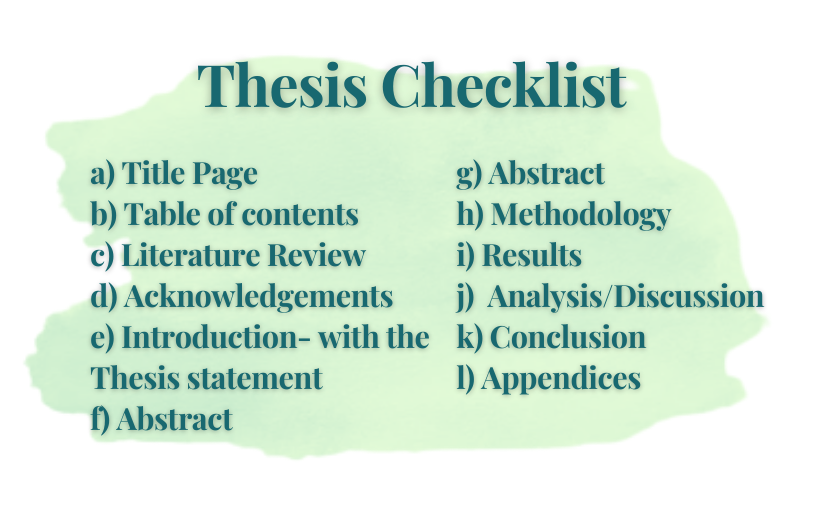

Components of a thesis you must follow in 2024
You must be at the end of your academic life as you are looking for a reliable source that can tell you how to write a thesis . Don’t worry! You have come to the right place! This article will tell you about the various elements of a thesis and all things to be kept in mind as you start writing one!
Table of Contents
What is a thesis .
A thesis is a long dissertation or research paper. It starts with a thesis statement which is the main point of your thesis paper . It can be a question, a statement, or an assessment. You will need to prove the thesis statement in your thesis with the help of the data that you collect and the analysis you come up with. These are part of the course requirement for university students, particularly those in the US.
There are different kinds of these- expository, analytical, and persuasive . An expository thesis paper explains a particular topic to the reader. An analytical thesis relies on your analysis of the theme or topic addressed, based on the detailed data you collect. A persuasive thesis paper argues to make and justify depending on your stance on a topic. Choose a suitable type of thesis paper, depending on your theme and thesis statement.
The format for writing a thesis is not usually very subjective; however, a few technical changes can occur in these by students of different institutes. Guidelines are specified by the university/advisor/professor/institute. Go over them before you start writing your thesis.
Include these essential components in your thesis
A person should be able to get information about the topic of a thesis and its author just by looking at the thesis. The title page of a thesis should include your name, the name of your course, institute, professor, or advisor along with your ID number and the title of your thesis. Write these things in bold letters and space them appropriately. Your details are as important as your thesis.
An index of all the contents of a thesis is like a good skeleton of the thesis, given at the very beginning. It includes the sections and subsections in the proper order of their occurrence in the thesis. Each heading should be a part of the table of contents along with the page numbers it starts and ends on respectively. The title and its respective page numbers need to be in the same horizontal line or row.
Acknowledgements
Here, you can mention all those who have helped you in your efforts to create an impressionable thesis. We would suggest describing how your colleagues supported you, your advisors guided you and your family looked after you as you worked on your thesis. Make sure you do not miss out on mentioning important people in your life.
Literature Review
The literature review is a list of all the sources of information that you used for reference. It can be substituted with a ‘References’ section at the end of your thesis. However, it is important to cite sources in a section dedicated to references. Specify the particular sections of research papers, articles, and journal entries you referred to in your thesis. The authors, page numbers, editors, publishers, and organizations need to be mentioned. In-text citations are required as well. The format of citation should be the one mentioned by your university/institute/advisor. The different citation formats are APA, MLA, Chicago, etc.
Thesis statement
The introduction should include the thesis statement. It is the most important thing in your thesis . It should convey the motive of your thesis. Restate the thesis statement in the conclusion. Your thesis statement can be creative, but not complex. You cannot work on something already worked on unless you want to disprove a theory or refer to it as you come up with a different argument. Every point that you explain in your thesis should be related to your thesis statement and should work towards proving the same.
Eg- There is a rise in mental health issues among university students who graduated between 2015 and 2022.
An abstract is like a summary of the thesis at the beginning of your thesis. It gives a reader an idea of what you would be covering in your thesis. Detailed explanations are not needed in the abstract. But it is important to state the main points from most of the sections- methodology, results, analysis, and conclusion. The abstract should not give away your research. It should just be like a concentration of your thesis.
Methodology
Your thesis starts getting detailed from here. A proper description of the methods you will be used to collect information and data relevant to your thesis should be stated in the ‘methodology’. Be sure to use methods that are suitable for your research and not those that are redundant. They need to be feasible. You should be able to execute the methods on your own.
Observations or results
This is one of the most important parts of your thesis. Following your methodology, come up with results that support your thesis statement. They need to be organized logically and, in a point-wise format. Highlight the keywords as you explain your results. You can also have a summary of your results if your results are too many and stretch over several pages. This will help readers remember important details.
This is a crucial part of your thesis. Your analysis shows how much you apply your knowledge to the data and come up with interesting implications. The points in the analysis need to be explained well and logically in order. Do not jump from one point to the other. Do not spring up new information out of the blue. Make sure that the explanations are easy to follow for a reader.
A conclusion includes a brief summary of your thesis . It should restate your thesis statement, followed by your findings and what you deciphered from the data you collected. Write down how the research you conducted impacts your field or humankind at large. Convey whether the point you started your thesis with was achieved or not. Did you come across something unexpected? Did your argument or thesis statement change as you started conducting research?
All the extra information and subsidiary data should go in the appendices at the end of your thesis. They should include details that are not directly connected to your thesis in a systematic format. Create different appendices to organize the contents logically. State the subheading along with its page number that contains the point that you are referring to in your appendix. The elements in the appendix should follow the order of their occurrence in the thesis. One should not be on top of the other if the latter comes before the former in the main thesis.
You can also include the following elements in case the format of your thesis is not rigid:
Contributor’s Page
This is a list of people who have worked on the thesis. If you are part of a group working on a single thesis, it would be better to include a contributor’s page. You can also include the credentials of the group members and the parts covered by them. Any personal details need to be edited before they can be included as part of a contributor’s credentials. Only those that are relevant would be better to consider.
Extra information
It is always better to make your thesis rich with details and evidence. Do not hesitate to include as much information as you want. The relevant details can be included in the main body of your thesis. However, subsidiary information needs to go in the appendices at the end of your thesis. Remember to explain each point in your thesis thoroughly. But do not bombard a reader with irrelevant information that can very well go in the appendices. It includes dates, days, and time frames that do not impact the thesis.
Tables, graphs, charts
To make your thesis interesting and inclusive of all forms of information, add graphs, tables, diagrams, images, and/or charts that are relevant to your research. Label these elements properly and insert them wherever necessary. They can be referred to further in your thesis to make a point. You will have to cite these elements in-text and add the citation to the references section of your thesis. Explain the elements properly in your thesis either before or after you have inserted them. They need to be clear to a reader. Extra charts and tables can go in the appendix.
A Final Thesis Checklist

Writing a thesis is no piece of cake. It requires months and at times years of dedication. The compilation can be difficult considering the large volume of information to be included in the thesis. It is easy to get overwhelmed by the work and the sections to be covered. You can take months to complete it. Don’t worry if you miss out on writing a particular section. You can always refer to this article and go over the basic elements of a thesis. Cross-check them with the sections and elements in your thesis. Edit your thesis properly before you submit it. Just stop procrastinating and start working! And don’t forget to enjoy the process!
-Masha Evans

Leave a Comment Cancel reply
Save my name, email, and website in this browser for the next time I comment.

an Excelsior University site
Parts of a Thesis Statement

The thesis statement is the key to most academic writing.
The purpose of academic writing is to offer your own insights, analyses, and ideas—to show not only that you understand the concepts you’re studying, but also that you have thought about those concepts in your own way, agreed or disagreed, or developed your own unique ideas as a result of your analysis. The thesis statement is the one sentence that encapsulates the result of your thinking, as it offers your main insight or argument in condensed form.
A basic thesis statement has two main parts:
- Topic: What you’re writing about
- Angle: What your main idea is about that topic
Topic: Regular exercise regime
Angle: Leads to multiple benefits Sample Thesis #2 Thesis: Adult college students have different experiences than typical, younger college students.
Topic: Adult college students
Angle: Have different experiences Sample Thesis #3 Thesis: The economics of television have made the viewing experience challenging for many viewers because shows are not offered regularly, similar programming occurs at the same time, and commercials are rampant.
Topic: Television viewing
Write | Read | Educators
Grumble... Applaud... Please give us your feedback!
Explore more
Check out other great resources:

- Click on the picture above to check out a blog post on generating a thesis statement and working thesis.
- The Writing Process »
- Parts of a Thesis Statement »

Chapter 6: The Writing Process and Pre-Writing
Elements of a Thesis Statement
When writing an essay, you must focus on a main idea . This idea will stem from a topic you have chosen or been assigned or from a question your instructor has asked. It is not enough merely to discuss a general topic or answer with a yes or no: you will need to form an opinion and then articulate it into a controlling idea – the main idea you will build your thesis on.
A thesis is not the topic itself, but rather your interpretation of the question or subject. When an instructor presents you with a topic, ask, “What do you want to say about it?” Asking and answering this question is vital to forming a thesis that is specific.
A thesis is typically one sentence long and appears near the end of your introduction. It is specific and focuses on one to three points related to a main idea: you will work to prove these points in the body of your paper. Thus, the thesis forecasts the content of the essay and how you will organize your information. A thesis statement does not summarize an issue but rather helps to dissect it.
A strong thesis statement
Click on the items below to understand the qualities of a strong thesis statement.
Activities: Check Your Understanding
Attribution statement.
Other than the activities, content for this page was adapted (with editorial changes) from:
Writing for Success 1st Canadian Edition by Tara Horkoff is licensed under a Creative Commons Attribution-NonCommercial-ShareAlike 4.0 International License , except where otherwise noted. Download for free at: https://opentextbc.ca/writingforsuccess/
The Scholarship of Writing in Nursing Education: 1st Canadian Edition Copyright © 2019 by Jennifer Lapum; Oona St-Amant; Michelle Hughes; Andy Tan; Arina Bogdan; Frances Dimaranan; Rachel Frantzke; and Nada Savicevic is licensed under a Creative Commons Attribution-ShareAlike 4.0 International License , except where otherwise noted.
Share This Book
- How It Works
- PhD thesis writing
- Master thesis writing
- Bachelor thesis writing
- Dissertation writing service
- Dissertation abstract writing
- Thesis proposal writing
- Thesis editing service
- Thesis proofreading service
- Thesis formatting service
- Coursework writing service
- Research paper writing service
- Architecture thesis writing
- Computer science thesis writing
- Engineering thesis writing
- History thesis writing
- MBA thesis writing
- Nursing dissertation writing
- Psychology dissertation writing
- Sociology thesis writing
- Statistics dissertation writing
- Buy dissertation online
- Write my dissertation
- Cheap thesis
- Cheap dissertation
- Custom dissertation
- Dissertation help
- Pay for thesis
- Pay for dissertation
- Senior thesis
- Write my thesis
Thesis Structure: Writing Guide For Your Success

If you are about to start writing your thesis, then it is extremely important to know as much as possible about the thesis structure. Learning the main thesis chapters should enable you to quickly structure your academic paper. Keep in mind that not structuring the paper correctly usually leads to severe penalties. We know some of you are probably having questions about numbering dissertation chapters. Basically, you just need to give all the major sections consecutive numbers. Use Arabic numerals (1, 2, 3, and so on). Check out the most frequently asked questions and them move on to the 7 parts of the thesis or dissertation structure.
Thesis Structure Frequently Asked Questions
- What is a basic good structure for a thesis? A: The best structure is the one listed below. It contains the 7 important parts any thesis should have.
- What does “the structure of this dissertation is in manuscript style” mean? A: It means that the thesis includes one or more manuscripts that have been written in a way that facilitates publication. The thesis can, in this case, be a collection of papers that have been written or co-authored by the student.
- Which chapters of dissertation are mandatory? A: All the 7 chapters below are necessary, if you want to get a top score on your paper.
- Where can I get a thesis structure template? A: You can quickly get a thesis structure example from one of our seasoned academic writers. Don’t base your thesis on mediocre samples you find online.
- What is the preferred thesis sentence structure? A: There is no set sentence structure that you have to follow. Just make sure your writing is organized in a logical manner and that all complex terms are explained the first time you use them.

Thesis Abstract
The first part of the thesis structure is the abstract. It is basically an overview of the entire paper. There is no set dissertation abstract structure. It is just a summary of your thesis and it should be just 200 to 300 words long.
Thesis Introduction
The introduction is one of the most important dissertation chapters. It should contain all of the following information:
A bit of background about the topic. Some information about the current knowledge. The aim of your research (the gap in knowledge that prompted you to write the thesis).
Remember that the introduction must present the thesis statement. It is very important to learn more about the thesis statement structure. A great thesis statement will pique the interest of the evaluation committee.
Thesis Literature Review
Many students who are looking to learn how to structure a thesis don’t know about the Literature Review section. Why? Because many people prefer to include it into the introduction. However, by separating the literature review from the intro, you can focus more on why your research is important. You can evaluate the most important research on your topic and clearly show the gap in knowledge.
Thesis Methods
In most cases, the Methods section is the easiest part of the structure of a thesis. All you have to do is present the method or methods you chose for the research. Don’t forget to also explain why you chose that specific research method. Your audience needs to understand that the chosen method is the best for the task.
Thesis Results
This is one of the most important chapters of a dissertation. In the Results chapter, you need to present your findings. Remember that written text is not enough. You need figures, stats, graphs, and other forms of data. This section contains all the facts of your research and should be written in an objective, neutral manner. It would be unusual for your to discuss your findings in this section.
Thesis Discussion
The Discussion chapter is very important in the dissertation chapters structure. It is the reason why you didn’t discuss your findings in the Results section. This is the section you can use to talk about your findings and provide your own opinions about the results. Here is what you can do in the discussion section:
Explain to the audience what your results mean for the scientific community. Comment on each of the results and discuss how your findings support your thesis. Explain any unexpected results so the evaluation committee can see that you know what you’re doing. Interpret the results and tie them with other research on the subject. How does your research help the academic community?
Thesis Conclusion
While not the most important chapter, the conclusion is one of the important chapters in a dissertation. It is the part where you can show your readers that you have achieved your research objectives. You can talk a bit about what you’ve learned in the process and even make some suggestions regarding the need for future research. In most cases, students also reiterate the thesis statement at the beginning of the conclusion, followed by a short summary of the paper’s most important chapters.
Still Not Sure How to Structure Thesis?
In case you are still struggling to find the best history dissertation structure, you should get some help as fast as possible. Remember that writing a thesis takes weeks, if not months. Don’t spend too much time trying to find the best structure. Instead, get in touch with a reliable academic company and get some quick assistance. For examples, one of our writers can create a thesis outline for you. You can just follow the outline and everything will be just fine.
Of course, you can also get some help with the thesis formatting. Citations and references can be difficult to master. Each academic writing style (MLA, Chicago, APA, etc.) has its own requirements. The way you format your academic paper is very important. Bolding and italicizing can emphasize certain ideas. A professional editor can help you make the thesis stand out from the rest. After all, a pleasantly-formatted dissertation that impresses the evaluation committee with its structure and quality of content has a very high chance of getting a top score.

Leave a Reply Cancel reply
Your email address will not be published. Required fields are marked *
Comment * Error message
Name * Error message
Email * Error message
Save my name, email, and website in this browser for the next time I comment.
As Putin continues killing civilians, bombing kindergartens, and threatening WWIII, Ukraine fights for the world's peaceful future.
Ukraine Live Updates
- + 1 321 - 251 - 6977
- Book Editing Services
- Fiction Editing
- nonfiction editing
- Authors Here
- Dissertation
- Universities & Institutions
- Academics Here
- Journals and Scientific PUBLICATIONS
- Academic Editing
- Scientific Manuscript
- Subject Matter Experts
- Researchers Here
- Business Editing
- Compare Editing Services
- Executives Here
- Consultation
- Editorial Critique Services
- Publishing Here
- Instant Price Quotes
- Coupons and Discounts
- Free Editing Sample & Critique
- Your Editing Team
- CERTIFIED Story Editors
- PhD & Subject Matter Experts
- About First Editing
- June 17, 2020
The Most Important Parts of a Dissertation or Thesis
- By Lindy Ledohowski

If you are a graduate student with a thesis or dissertation to write, the project can be incredibly daunting.
Where and how to begin? What are the component parts? How is a thesis different from a dissertation? What is methodology? How do I write a literature review? What is the analysis section?
These (and many more) may be the types of questions that you have when it comes to writing your thesis or dissertation.
While the details of your thesis or dissertation will differ from institution to institution, and it is up to you to know what your institution, department, committee, and supervisor are expecting from you, I’ve collected a number of common elements that many theses and dissertations will include.
First things first, let’s start with definitions. What is the difference between a dissertation and a thesis?
Broadly speaking, these two projects may refer to the same thing, or they may be two different things. How’s that for confusing?
To clarify further, a thesis generally refers to a research paper at the Master’s degree level, and a dissertation generally refers to a much longer, book-length research project at the Doctoral level.
However, in some countries, a Master’s thesis might be called a dissertation, and a PhD dissertation might be called a thesis. That said, at the Master’s level students writing a thesis/dissertation will write up a shorter research paper, but a doctoral level project will be a multi-year research endeavour.
Given that, each might have the following key sections:
Introduction & Problem Statement
Literature Review
Methodology Section
Depending on your field or whether this is a Master’s or Doctoral level piece of research, these sections may be longer or more sophisticated. That said, it’s helpful to know what each entails just so that you’re familiar with the component parts, and you have some tips for each section.
Your introduction sets out the context and situates the specific problem that your research addresses. It should include:
- Relevant historical, geographical, or technical information that is relevant to your broader field and your problem in particular.
- A clear articulation of the problem(s) that your research seeks to address.
- If your particular problem or query is part of a larger study or a larger academic conversation around a topic, state that clearly in your introduction.
A literature review is NOT an annotated bibliography or a mere summary of the relevant research. Instead it is a section that demonstrates you have done the relevant reading and research and made sense of that external research. Some tips include:
- Try to group related research together. Are there schools of thought or approaches that different scholars share? Try to summarise their work in categories rather than simply listing one by one.
- Organise the scholarship in a roughly chronological order. It does not make sense to put findings from widely varying decades next to each other without a clear rationale.
This portion of your thesis or dissertation offers you the opportunity to say something about the field in which you work. How do researchers in your field do their work? Is it data-intensive, close reading, theoretical, historical, etc? Some things to consider:
- Each discipline has its own way of doing things, and most fields even have differences within their fields. Not all scholars do work the same way. Clearly state the scope of your research, especially if it is informed by a standard or well-known approach.
- If your method or approach to the research is different or unexpected, this is the place to flag that for your reader.
Depending on your field and the required length of your dissertation or thesis, this portion is the most important part of your research. In this section – be it a theoretical analysis or an evaluation of scientific findings or an assertion of causation based on data – you demonstrate how you make sense of your research. In a doctoral level project, this portion is usually multiple chapters. This section is the opportunity for you to showcase why your research matters. Some things to answer as you approach this portion:
- Are you outlining the significance of new research findings?
- Are you clarifying something in the field?
- Are you qualifying or justifying something that is standard in your discipline?
- Have you exposed something that is often overlooked by other researchers?
Often the conclusion to a long research project like a dissertation or thesis seems rather anticlimactic, but it is, in fact, rather important! Not only are you summarising the most important elements of your findings, but you are also demonstrating how your research can be extrapolated further. For example, you might gesture towards:
- What are some areas that your research opens up for further investigation?
- What other disciplines are impacted by your work?
- What other questions do your findings raise?
- What things do you wish you had explored, but didn’t within the scope of this project?
If you already have a rough draft or outline for your thesis or dissertation, then, great, you are set, and you can tweak and refine it with these insights.
If you are just getting started, then you can take this advice and run with it. I’ve also written about how you can write a dissertation and publish along the way, so make sure you think about the broader research and publication potential that your work possesses.
And, of course, good luck and have fun!
- Frequently Asked Questions
Share With :

Author Services
- Nonfiction Editing
- Copy Editing
- Content Editing
- Line Editing Services
- Proofreading Services
- Additional Editing Services
- Editing Consultation
- Business Copy Editing Services
Academic & Scientific Researchers
- Academic English Editing
- Scientific Research Editing
- Technical Copy Editing
- Universities & Institutions
- Thesis Editing
- Dissertation Editing
- How to Cite White Papers
Editing Help
- Editing Service Price Quote
- Client Login
- Satisfaction Guarantee
- Terms of Service
- Return Policy
- Privacy Policy
- Cookies Policy
Writer Resources
- Samples of Editing Levels
- PODCAST – Publishing Power!
- BLOG for Writers
- Writing Tools
- Coupons & Special Offers
About FirstEditing
- CERTIFIED Structural Editors
- Published Authors
- Customer Reviews
- Professional Editors
- Affiliate Program
- Partner with First Editing
- Refer a Friend
- Editing Jobs
- Guest Blogging

Publications

© 1994-2024 FirstEditing.Com, Inc. – Providing Proofreading & Editing Services Worldwide
COUPON QUIZ Which countries celebrate Christmas on Dec 24th?
Get 15% Off Now Expires December 25
Add Your Heading Text Here
Lorem ipsum dolor sit amet, consectetur adipiscing elit. Ut elit tellus, luctus nec ullamcorper mattis, pulvinar dapibus leo.

Undergraduate Thesis
- Preparing for Thesis
Elements of Thesis
- List of References
- Images and Figures
- Library Home

Front Matter
There are three sections of your thesis. they must include all elements listed here and be formatted correctly. click on each section to see guidelines, templates, and examples., front matter.
These sections are divided into six Design Tasks in AR501:
- << Previous: Preparing for Thesis
- Next: Layout >>
- Last Updated: Apr 23, 2024 7:16 PM
- URL: https://library.newschoolarch.edu/ugthesis

IMAGES
COMMENTS
Jun 10, 2022 · It starts with a thesis statement which is the main point of your thesis paper. It can be a question, a statement, or an assessment. It can be a question, a statement, or an assessment. You will need to prove the thesis statement in your thesis with the help of the data that you collect and the analysis you come up with.
• A thesis statement generally consists of two parts: your topic, followed by analysis, explanation(s), or assertion(s) that you’re making about the topic. • A thesis statement is a specific statement. It should cover only what you want to discuss in your paper and must be supported with specific evidence.
• A thesis statement generally consists of two parts: your topic, and then the analysis, explanation(s), or assertion(s) that you're making about the topic. The kind of thesis statement you write will depend on what kind of paper you're writing. • In some kinds of writing, such as narratives or descriptions, a thesis statement is less
The thesis statement is the one sentence that encapsulates the result of your thinking, as it offers your main insight or argument in condensed form. A basic thesis statement has two main parts: Topic: What you’re writing about; Angle: What your main idea is about that topic
A thesis is not the topic itself, but rather your interpretation of the question or subject. When an instructor presents you with a topic, ask, “What do you want to say about it?” Asking and answering this question is vital to forming a thesis that is specific. A thesis is typically one sentence long and appears near the end of your ...
The Important Components of a Thesis This thesis writing manual is used to guide you to effectively write a thesis, independent study project and for the research completion. There are 3 essential parts required for major components of your thesis or dissertation as shown below; 1. Cover leading 2. Contents 3. Formatting endnotes 1. Cover Leading
What is a basic good structure for a thesis? A: The best structure is the one listed below. It contains the 7 important parts any thesis should have. What does “the structure of this dissertation is in manuscript style” mean? A: It means that the thesis includes one or more manuscripts that have been written in a way that facilitates ...
To clarify further, a thesis generally refers to a research paper at the Master’s degree level, and a dissertation generally refers to a much longer, book-length research project at the Doctoral level. However, in some countries, a Master’s thesis might be called a dissertation, and a PhD dissertation might be called a thesis.
Apr 23, 2024 · There are three sections of your thesis. They must include all elements listed here and be formatted correctly. Click on each section to see guidelines, templates, and examples.
Maintain the Thesis' Important Characteristics Throughout Your Essay. Revise the adjustable working thesis as you write the composition while maintaining the thesis' significant characteristics. If you come up with a fundamental, essential or organizing question about your composition, an effective two-part thesis must answer that question.